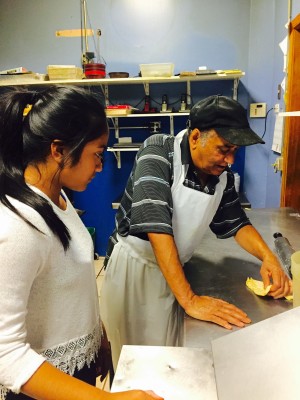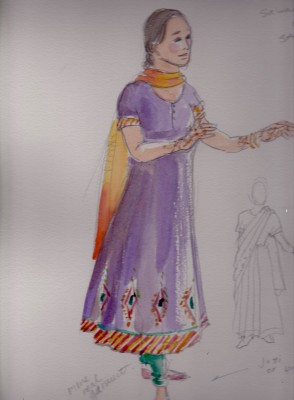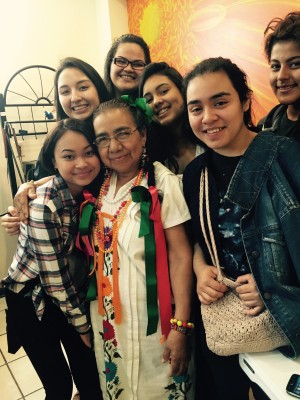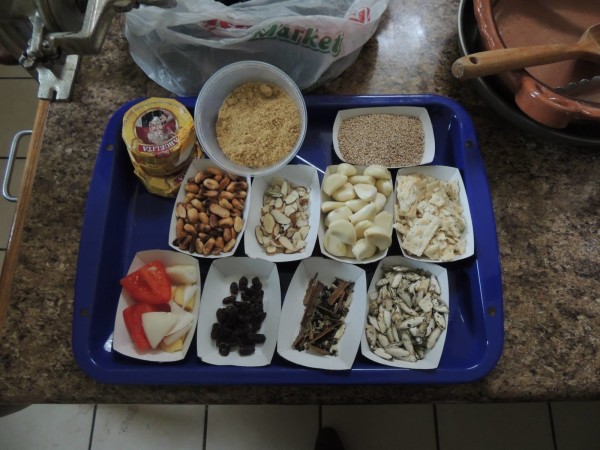APTP Artistic Director David Feiner speaks with Goodman Theatre’s OnStage Editor Michael Mellini about revisiting Feast, exploring Chicago’s thriving food scene, and the fifth collaboration between APTP and the Goodman.

APTP ensemble member Alyanna Parajado conducts research about Indian culinary traditions in the kitchen of Paprika Restaurant with Chef Shah Kabir.
Michael Mellini: Albany Park Theater Project has a unique way of creating its work. Can you describe that process for audiences who may not be familiar with how the group operates?
David Feiner: A new project always begins with a theme or question about our city or country that we think is relevant, but perhaps isn’t being explored on stage. With Feast we were interested not only in the role food plays in nourishing the individual body, but also in how food can nourish entire communities. We wanted to explore the role food plays during migrations because Albany Park, and Chicago in general, is such an immigrant-rich area and home to people from all over the world. We were interested in the way food functions in adaptation to a new home and yet keeps us connected to where we came from originally. Communities get created around food as so many immigrants build their livelihood around food when they migrate. APTP is always exploring themes of social justice, so we were also interested in the exploitation of food workers as well as the pioneers who are trying to create a more sustainable and just food production system. As you can see, we started with this very large theme and explored tons of ideas.

Costume design by Izumi Inaba for character played by Alyanna Parajado in Feast.
MM: How did you go about investigating these stories?
DF: We journeyed to immigrant communities throughout the city, asking people to point us to their favorite neighborhood spots, street carts, home kitchens, festivals, butchers, bodegas, farmers, gardens and markets. Places at the heart of immigrant communities. We did a lot of eating during the process of building Feast! The youth of the ensemble introduced themselves—often after enjoying a tamale on the street or picking up sausages in a butcher shop—to the people behind the shops and asked if they could interview them, get their life story and learn about their journey to where they are today in terms of food. We conducted probably two dozen interviews.
MM: This is the second production of Feast at Goodman Theatre. Will this production vary from the original?
DF: We’re trying to make Feast into the theatrical equivalent of your favorite restaurant; it’s like a place you want to come back to because you want to eat favorite menu items and also because you want to see what the chef is serving up that’s new. The design of this new Feast transforms the Goodman’s Owen Theatre to create a community atmosphere and sense of celebration. We want audience members to feel like they are gathering around a great big table to break bread together. This year’s Feast opens with a joyous new sequence inspired by food markets from around the world: our 25 performers will fill the entire Owen Theatre – from the stage to the mezzanine up to the balcony – with a dance and rhythmic performance that captures the vitality of food markets.

APTP ensemble members interviewed women who started a Mole Festival in the Little Village community.
Another new addition to Feast this year is inspired by interviews we conducted at Universidad Popular in Little Village, with a women’s collective that created a glorious mole [Mexican sauce] festival that has become a catalyst for empowerment and entrepreneurship—for preserving inherited traditions and creating new traditions—and of course, for deliciousness. The six young women from our ensemble who interviewed the women from the Mole Festival saw their own mothers and grandmothers in the stories they heard. There were a lot of tears – of struggle, of loss, of recognition, of triumph. The food was astonishing – and these master moleras (women who make mole) shared the secrets of their recipes in a cooking class with our company members. On stage, we’ve transformed these recipes and stories into a beautiful song – it’s more than a song, I call it our mole anthem. It celebrates not only a sacred food, but also the transformation of oppression and loss into strength and power – in this case by women in Chicago’s Mexican immigrant communities.

A sweets-loving character from the original Feast will have new adventures in this year's production.
We’ve also imagined delightful new adventures for a favorite character from the 2010 Feast – a clown-like young boy from Puerto Rico with a taste for sweets that keeps getting him in trouble. This year, this mischievous fellow will meet his match in a young girl the Philippines.
MM: Why has the Goodman’s partnership with APTP been meaningful to the company these past five years?
DF: The partnership has introduced close to 10,000 new audience members to APTP. It’s allowed us to conceive our work on a larger canvas. We love creating work in our black box space in our home theater, but because our work is so physical and visual, coming to the Owen and adapting something we’ve made in an intimate environment to a larger space is exciting. We hope to imagine things that haven’t been done on stage before and to surprise our audience and ourselves with what’s possible in a theatrical space, and the Goodman’s production team is able to help us do that in ways we didn’t previously dream. It’s really exciting to feel like we are part of communicating the message that the Goodman is a home for audiences from every neighborhood of Chicago. We’re proud to be part of that. This feels like a place where we belong and where we can contribute.
 Menu
Menu
